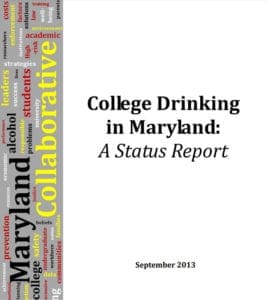College Drinking in Maryland: A Status Report
This report, published in 2013, details what was learned during the first year of planning for the Maryland Collaborative. Information was gathered using a variety of methods, including discussions with community leaders, administrators, and staff from 38 schools in Maryland, along with various analyses of publicly-available administrative data. We learned about the current status of the problem, its radiating effects on Maryland communities, and the strategies being implemented to address the problem.
 Key Findings
Key Findings
College student drinking is a complex problem that can only be reduced by simultaneously implementing efforts to change individual behavior with strategies to modify the campus and community environments that heavily influence student decisions to drink. There is a high level of recognition that excessive drinking among students is a problem and adversely influences student health, safety, and functioning.
College students in Maryland have drinking patterns similar to those of their counter parts across the country, with some indication of even heavier patterns and less utilization of services among the highest risk drinkers in Maryland. Many schools are engaged in a variety of prevention and intervention activities, and campus leaders are eager to learn how to maximize the impact of their existing approaches and prevention activities.
It is fully recognized that the issue does not only concern Maryland’s colleges, but also the communities surrounding the colleges, and ultimately the entire state is affected. There are several community leaders who are interested in working with schools to address student drinking problems. There is a scarcity of standardized methods being used to measure alcohol use and related problems. Yet there are many opportunities for gathering such information and implementing common methods across different sets of schools (e.g., community colleges, private colleges, public schools) and the Maryland Collaborative seeks to create this uniformity through a standardized measurement tool, called the Maryland College Alcohol Survey.
